Horizontal CO2 Compensation in the Yangtze River Delta Based on CO2 Footprints and CO2 Emissions Efficiency
Abstract
:1. Introduction
2. Literature Review and Study Framework
3. Data and Methods
3.1. Data Collection
3.2. Methods
3.2.1. Estimation of the CO2 Footprints
3.2.2. Estimation of CO2 Emissions Efficiency
3.2.3. Horizontal CO2 Compensation Model
4. Results
4.1. Spatio-Temporal Evolution of CO2 Footprints
4.1.1. Accuracy Checking of Municipal CO2 Footprints
4.1.2. Evolutionary Characteristics of the CO2 Footprints
4.2. Spatio-Temporal Evolution of CO2 Emissions Efficiency
4.3. Horizontal CO2 Compensation Scenarios
4.3.1. Horizontal CO2 Compensation Based on CO2 Footprints
4.3.2. Horizontal CO2 Compensation Based on CO2 Trading with a Price Mechanism Determined by CO2 Emissions Efficiency
5. Conclusions and Discussion
5.1. Conclusions
5.2. Recommendations
5.3. Discussion
Author Contributions
Funding
Institutional Review Board Statement
Informed Consent Statement
Data Availability Statement
Conflicts of Interest
References
- Mohsin, M.; Naseem, S.; Sarfraz, M.; Azam, T. Assessing the effects of fuel energy consumption, foreign direct investment and GDP on CO2 emission: New data science evidence from Europe & Central Asia. Fuel 2022, 314, 123098. [Google Scholar] [CrossRef]
- Sarfraz, M.; Naseem, S.; Mohsin, M.; Bhutta, M.S.; Jaffri, Z.U.A.; Chen, C.; Zhang, Z.; Wei, L.; Qiu, Y.; Xu, W.; et al. Recent analytical tools to mitigate carbon-based pollution: New insights by using wavelet coherence for a sustainable environment. Environ. Res. 2022, 212, 113074. [Google Scholar] [CrossRef] [PubMed]
- Ali, U.; Guo, Q.; Kartal, M.T.; Nurgazina, Z.; Khan, Z.A.; Sharif, A. The impact of renewable and non-renewable energy consumption on carbon emission intensity in China: Fresh evidence from novel dynamic ARDL simulations. J. Environ. Manag. 2022, 320, 115782. [Google Scholar] [CrossRef] [PubMed]
- Zhou, S.; Li, W.; Lu, Z.; Lu, Z. A technical framework for integrating carbon emission peaking factors into the industrial green transformation planning of a city cluster in China. J. Clean. Prod. 2022, 344, 131091. [Google Scholar] [CrossRef]
- Tian, S.; Xu, Y.; Wang, Q.; Zhang, Y.; Yuan, X.; Ma, Q.; Chen, L.; Ma, H.; Liu, J.; Liu, C. Research on peak prediction of urban differentiated carbon emissions—A case study of Shandong Province, China. J. Clean. Prod. 2022, 374, 134050. [Google Scholar] [CrossRef]
- Sheng, J.; Qiu, W.; Han, X. China’s PES-like horizontal eco-compensation program: Combining market-oriented mechanisms and government interventions. Ecosyst. Serv. 2020, 45, 101164. [Google Scholar] [CrossRef]
- Yang, G.; Shang, P.; He, L.; Zhang, Y.; Wang, Y.; Zhang, F.; Zhu, L.; Wang, Y. Interregional carbon compensation cost forecast and priority index calculation based on the theoretical carbon deficit: China as a case. Sci. Total. Environ. 2019, 654, 786–800. [Google Scholar] [CrossRef]
- Welch, R. Monitoring urban population and energy utilization patterns from satellite Data. Remote Sens. Environ. 1980, 9, 1–9. [Google Scholar] [CrossRef]
- Hu, X.F.; Zou, Y.; Fu, C. Spatial and temporal patterns of the ecological compensation criterion in Jiangxi Province, China based on carbon footprint. Chin. J. Appl. Ecol. 2017, 28, 493–499. [Google Scholar]
- Yang, Y.; Zhang, Y.; Yang, H.; Yang, F. Horizontal ecological compensation as a tool for sustainable development of urban agglomerations: Exploration of the realization mechanism of Guanzhong Plain urban agglomeration in China. Environ. Sci. Policy 2022, 137, 301–313. [Google Scholar] [CrossRef]
- Yuan, X.; Sheng, X.; Chen, L.; Tang, Y.; Li, Y.; Jia, Y.; Qu, D.; Wang, Q.; Ma, Q.; Zuo, J. Carbon footprint and embodied carbon transfer at the provincial level of the Yellow River Basin. Sci. Total Environ. 2022, 803, 149993. [Google Scholar] [CrossRef]
- Zhang, L.; Ruiz-Menjivar, J.; Tong, Q.; Zhang, J.; Yue, M. Examining the carbon footprint of rice production and consumption in Hubei, China: A life cycle assessment and uncertainty analysis approach. J. Environ. Manag. 2021, 300, 113698. [Google Scholar] [CrossRef] [PubMed]
- Long, Y.; Yoshida, Y.; Liu, Q.; Zhang, H.; Wang, S.; Fang, K. Comparison of city-level carbon footprint evaluation by applying single- and multi-regional input-output tables. J. Environ. Manag. 2020, 260, 110108. [Google Scholar] [CrossRef] [PubMed]
- Zhu, W.; Feng, W.; Li, X.; Zhang, Z. Analysis of the embodied carbon dioxide in the building sector: A case of China. J. Clean. Prod. 2020, 269, 122438. [Google Scholar] [CrossRef]
- Li, Q.; Gao, M.; Li, J. Carbon emissions inventory of farm size pig husbandry combining Manure-DNDC model and IPCC coefficient methodology. J. Clean. Prod. 2021, 320, 128854. [Google Scholar] [CrossRef]
- Liu, Z.; Guan, D.; Wei, W.; Davis, S.J.; Ciais, P.; Bai, J.; Peng, S.; Zhang, Q.; Hubacek, K.; Marland, G.; et al. Reduced carbon emission estimates from fossil fuel combustion and cement production in China. Nature 2015, 524, 335–338. [Google Scholar] [CrossRef] [Green Version]
- Ohms, P.K.; Laurent, A.; Hauschild, M.Z.; Ryberg, M.W. Consumption-based screening of climate change footprints for cities worldwide. J. Clean. Prod. 2022, 377, 134197. [Google Scholar] [CrossRef]
- Elvidge, C.D.; Baugh, K.E.; Kihn, E.A.; Kroehl, H.W.; Davis, E.R.; Davis, C.W. Relation between satellite observed visible-near infrared emissions, population, economic activity and electric power consumption. Int. J. Remote Sens. 1997, 18, 1373–1379. [Google Scholar] [CrossRef]
- Doll, C.H.; Muller, J.-P.; Elvidge, C.D. Night-time Imagery as a Tool for Global Mapping of Socioeconomic Parameters and Greenhouse Gas Emissions. AMBIO J. Hum. Environ. 2000, 29, 157–162. [Google Scholar] [CrossRef]
- Li, J.; He, S.; Wang, J.; Ma, W.; Ye, H. Investigating the spatiotemporal changes and driving factors of nighttime light patterns in RCEP Countries based on remote sensed satellite images. J. Clean. Prod. 2022, 359, 131944. [Google Scholar] [CrossRef]
- Liu, H.; Ma, L.; Xu, L. Estimating spatiotemporal dynamics of county-level fossil fuel consumption based on integrated nighttime light data. J. Clean. Prod. 2021, 278, 123427. [Google Scholar] [CrossRef]
- Wei, W.; Zhang, X.; Zhou, L.; Xie, B.; Zhou, J.; Li, C. How does spatiotemporal variations and impact factors in CO2 emissions differ across cities in China? Investigation on grid scale and geographic detection method. J. Clean. Prod. 2021, 321, 128933. [Google Scholar] [CrossRef]
- Dar, A.A.; Hameed, J.; Huo, C.; Sarfraz, M.; Albasher, G.; Wang, C.; Nawaz, A. Recent optimization and panelizing measures for green energy projects; insights into CO2 emission influencing to circular economy. Fuel 2022, 314, 123094. [Google Scholar] [CrossRef]
- Shah, W.U.H.; Hao, G.; Yan, H.; Yasmeen, R.; Jie, Y. The role of energy policy transition, regional energy efficiency, and technological advancement in the improvement of China’s environmental quality. Energy Rep. 2022, 8, 9846–9857. [Google Scholar] [CrossRef]
- Zhang, J.; Xing, Z.; Wang, J. Analysis of CO2 Emission Performance and Abatement Potential for Municipal Industrial Sectors in Jiangsu, China. Sustainability 2016, 8, 697. [Google Scholar] [CrossRef] [Green Version]
- Tian, Z.; Ren, F.-R.; Xiao, Q.-W.; Chiu, Y.-H.; Lin, T.-Y. Cross-Regional Comparative Study on Carbon Emission Efficiency of China’s Yangtze River Economic Belt Based on the Meta-Frontier. Int. J. Environ. Res. Public Health 2019, 16, 619. [Google Scholar] [CrossRef] [PubMed] [Green Version]
- Sun, J.; Dong, F. Decomposition of carbon emission reduction efficiency and potential for clean energy power: Evidence from 58 countries. J. Clean. Prod. 2022, 363, 132312. [Google Scholar] [CrossRef]
- Wen, S.; Jia, Z.; Chen, X. Can low-carbon city pilot policies significantly improve carbon emission efficiency? Empirical evidence from China. J. Clean. Prod. 2022, 346, 131131. [Google Scholar] [CrossRef]
- Teng, X.; Liu, F.-P.; Chiu, Y.-H. The change in energy and carbon emissions efficiency after afforestation in China by applying a modified dynamic SBM model. Energy 2021, 216, 119301. [Google Scholar] [CrossRef]
- Zhao, P.; Zeng, L.; Li, P.; Lu, H.; Hu, H.; Li, C.; Zheng, M.; Li, H.; Yu, Z.; Yuan, D.; et al. China’s transportation sector carbon dioxide emissions efficiency and its influencing factors based on the EBM DEA model with undesirable outputs and spatial Durbin model. Energy 2022, 238, 121934. [Google Scholar] [CrossRef]
- Wu, H.; Huang, H.; Chen, W.; Meng, Y. Estimation and spatiotemporal analysis of the carbon-emission efficiency of crop production in China. J. Clean. Prod. 2022, 371, 133516. [Google Scholar] [CrossRef]
- Xie, Z.; Wu, R.; Wang, S. How technological progress affects the carbon emission efficiency? Evidence from national panel quantile regression. J. Clean. Prod. 2021, 307, 127133. [Google Scholar] [CrossRef]
- Qu, Y.; Cang, Y. Cost-benefit allocation of collaborative carbon emissions reduction considering fairness concerns—A case study of the Yangtze River Delta, China. J. Environ. Manag. 2022, 321, 115853. [Google Scholar] [CrossRef] [PubMed]
- Sheng, W.; Zhen, L.; Xie, G.; Xiao, Y. Determining eco-compensation standards based on the ecosystem services value of the mountain ecological forests in Beijing, China. Ecosyst. Serv. 2017, 26, 422–430. [Google Scholar] [CrossRef]
- Arowolo, A.O.; Deng, X.; Olatunji, O.A.; Obayelu, A.E. Assessing changes in the value of ecosystem services in response to land-use/land-cover dynamics in Nigeria. Sci. Total Environ. 2018, 636, 597–609. [Google Scholar] [CrossRef] [PubMed]
- Zugravu-Soilita, N. The impact of trade in environmental goods on pollution: What are we learning from the transition economies’ experience? Environ. Econ. Policy Stud. 2018, 20, 785–827. [Google Scholar] [CrossRef]
- Sturm, B.; Pei, J.; Wang, R.; Löschel, A.; Zhao, Z. Conditional cooperation in case of a global public good – Experimental evidence from climate change mitigation in Beijing. China Econ. Rev. 2019, 56, 101308. [Google Scholar] [CrossRef]
- Liu, M.; Zhou, C.; Lu, F.; Hu, X. Impact of the implementation of carbon emission trading on corporate financial performance: Evidence from listed companies in China. PLoS ONE 2021, 16, e0253460. [Google Scholar] [CrossRef]
- Teixidó-Figueras, J.; Steinberger, J.K.; Krausmann, F.; Haberl, H.; Wiedmann, T.; Peters, G.P.; Duro, J.A.; Kastner, T. International inequality of environmental pressures: Decomposition and comparative analysis. Ecol. Indic. 2016, 62, 163–173. [Google Scholar] [CrossRef] [Green Version]
- Byrne, J.; Martinez, C.; Ruggero, C. Relocating Energy in the Social Commons. Bull. Sci. Technol. Soc. 2009, 29, 81–94. [Google Scholar] [CrossRef] [Green Version]
- Engel, S.; Palmer, C.; Taschini, L.; Urech, S. Conservation Payments under Uncertainty. Land Econ. 2015, 91, 36–56. [Google Scholar] [CrossRef]
- Xiong, K.; Kong, F. The Analysis of Farmers’ Willingness to Accept and Its Influencing Factors for Ecological Compensation of Poyang Lake Wetland. Procedia Eng. 2017, 174, 835–842. [Google Scholar] [CrossRef]
- Cui, Q.; Wang, X.; Li, C.; Cai, Y.; Liu, Q.; Li, R. Ecosystem service value analysis of CO2 management based on land use change of Zoige alpine peat wetland, Tibetan Plateau. Ecol. Eng. 2015, 76, 158–165. [Google Scholar] [CrossRef]
- Alberini, A.; Bigano, A.; Ščasný, M.; Zvěřinová, I. Preferences for Energy Efficiency vs. Renewables: What Is the Willingness to Pay to Reduce CO2 Emissions? Ecol. Econ. 2018, 144, 171–185. [Google Scholar] [CrossRef]
- Fu, B.; Wang, Y.; Xu, P.; Yan, K.; Li, M. Value of ecosystem hydropower service and its impact on the payment for ecosystem services. Sci. Total Environ. 2014, 472, 338–346. [Google Scholar] [CrossRef]
- Yu, B.; Xu, L.; Yang, Z. Ecological compensation for inundated habitats in hydropower developments based on carbon stock balance. J. Clean. Prod. 2016, 114, 334–342. [Google Scholar] [CrossRef]
- Jing, X.; Tian, G.; Li, M.; Javeed, S.A. Research on the Spatial and Temporal Differences of China’s Provincial Carbon Emissions and Ecological Compensation Based on Land Carbon Budget Accounting. Int. J. Environ. Res. Public Health 2021, 18, 12892. [Google Scholar] [CrossRef] [PubMed]
- Peng, Z.; Pu, H.; Huang, X.; Zheng, R.; Xu, L. Study on public willingness and incentive mechanism of ecological compensation for inter-basin water transfer in China in the carbon neutral perspective. Ecol. Indic. 2022, 143, 109397. [Google Scholar] [CrossRef]
- Hu, T.; Wang, T.; Yan, Q.; Chen, T.; Jin, S.; Hu, J. Modeling the spatiotemporal dynamics of global electric power consumption (1992–2019) by utilizing consistent nighttime light data from DMSP-OLS and NPP-VIIRS. Appl. Energy 2022, 322, 119473. [Google Scholar] [CrossRef]
- Zheng, Y.; Tang, L.; Wang, H. An improved approach for monitoring urban built-up areas by combining NPP-VIIRS nighttime light, NDVI, NDWI and NDBI. J. Clean. Prod. 2021, 328, 129488. [Google Scholar] [CrossRef]
- Zhang, Y.; Pan, J. Spatio-temporal simulation and differentiation pattern of carbon emissions in China based on DMSP/OLS nighttime light data. China Environ. Sci. 2019, 39, 1436–1446. [Google Scholar] [CrossRef]
- Li, X.; Zhou, Y.; Zhao, M.; Zhao, X. A harmonized global nighttime light dataset 1992–2018. Sci. Data 2020, 7, 168. [Google Scholar] [CrossRef] [PubMed]
- Wei, L.; Wang, Z. Differentiation Analysis on Carbon Emission Efficiency and Its Factors at Different Industrialization Stages: Evidence from Mainland China. Int. J. Environ. Res. Public Health 2022, 19, 16650. [Google Scholar] [CrossRef]
- Fu, J.; Ding, R.; Zhang, Y.; Zhou, T.; Du, Y.; Zhu, Y.; Du, L.; Peng, L.; Zou, J.; Xiao, W. The Spatial-Temporal Transition and Influencing Factors of Green and Low-Carbon Utilization Efficiency of Urban Land in China under the Goal of Carbon Neutralization. Int. J. Environ. Res. Public Health 2022, 19, 16149. [Google Scholar] [CrossRef]
- Zeng, T.; Jin, H.; Geng, Z.; Kang, Z.; Zhang, Z. The Effect of Urban Shrinkage on Carbon Dioxide Emissions Efficiency in Northeast China. Int. J. Environ. Res. Public Health 2022, 19, 5772. [Google Scholar] [CrossRef] [PubMed]
- Zheng, R.; Cheng, Y.; Liu, H.; Chen, W.; Chen, X.; Wang, Y. The Spatiotemporal Distribution and Drivers of Urban Carbon Emission Efficiency: The Role of Technological Innovation. Int. J. Environ. Res. Public Health 2022, 19, 9111. [Google Scholar] [CrossRef]
- Liu, L.; Zhang, Y.; Gong, X.; Li, M.; Li, X.; Ren, D.; Jiang, P. Impact of Digital Economy Development on Carbon Emission Efficiency: A Spatial Econometric Analysis Based on Chinese Provinces and Cities. Int. J. Environ. Res. Public Health 2022, 19, 14838. [Google Scholar] [CrossRef] [PubMed]
- Xu, Y.; Cheng, Y.; Zheng, R.; Wang, Y. Spatiotemporal Evolution and Influencing Factors of Carbon Emission Efficiency in the Yellow River Basin of China: Comparative Analysis of Resource and Non-Resource-Based Cities. Int. J. Environ. Res. Public Health 2022, 19, 11625. [Google Scholar] [CrossRef]
- Shi, B.; Li, N.; Gao, Q.; Li, G. Market incentives, carbon quota allocation and carbon emission reduction: Evidence from China’s carbon trading pilot policy. J. Environ. Manag. 2022, 319, 115650. [Google Scholar] [CrossRef]
- Zhao, R.; Liu, Y.; Ma, L.; Li, Y.; Hou, L.; Zhang, Z.; Ding, M. County-level carbon compensation of Henan province based on carbon budget estimation. J. Nat. Resour. 2016, 31, 1675–1687. [Google Scholar] [CrossRef]
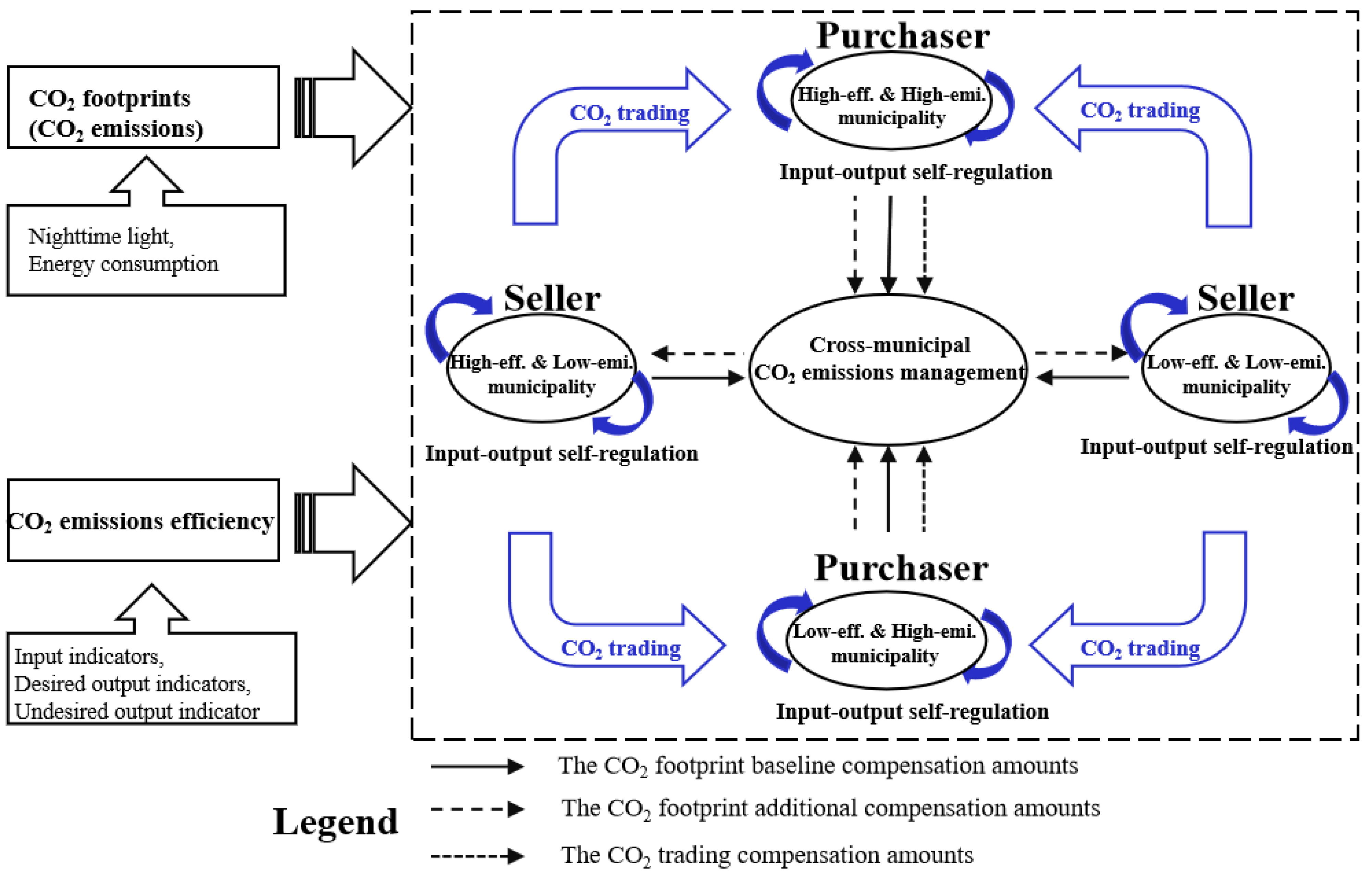
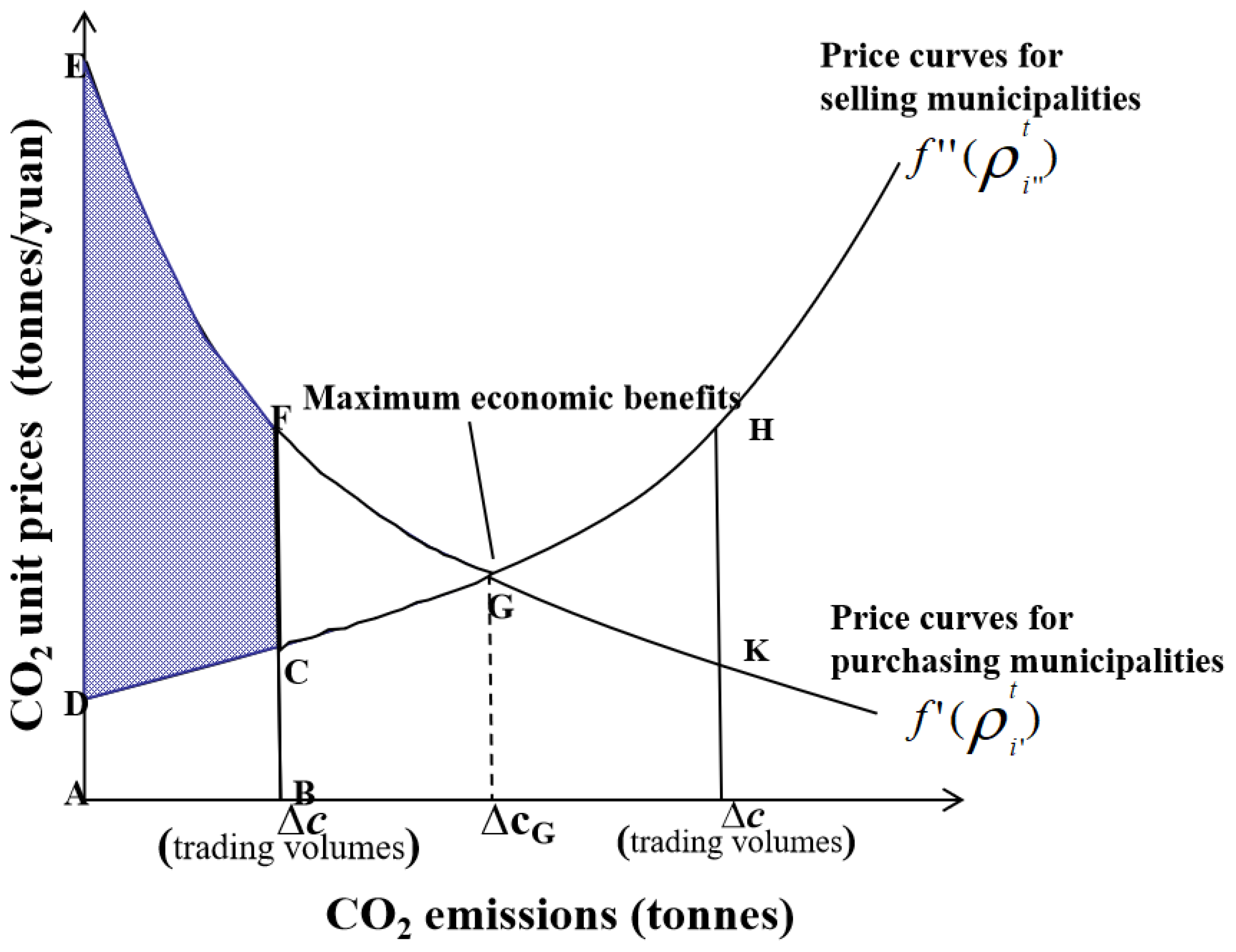

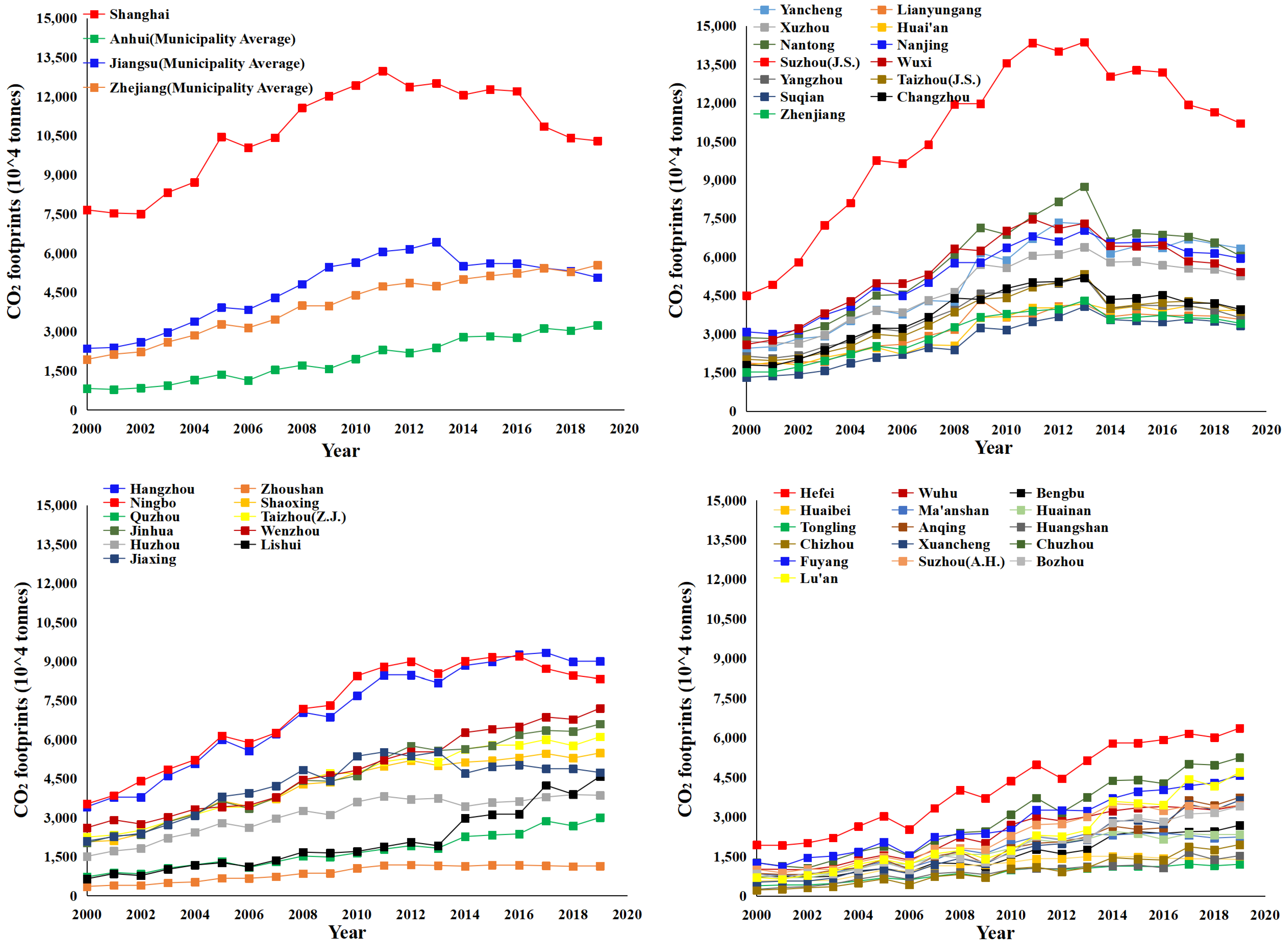
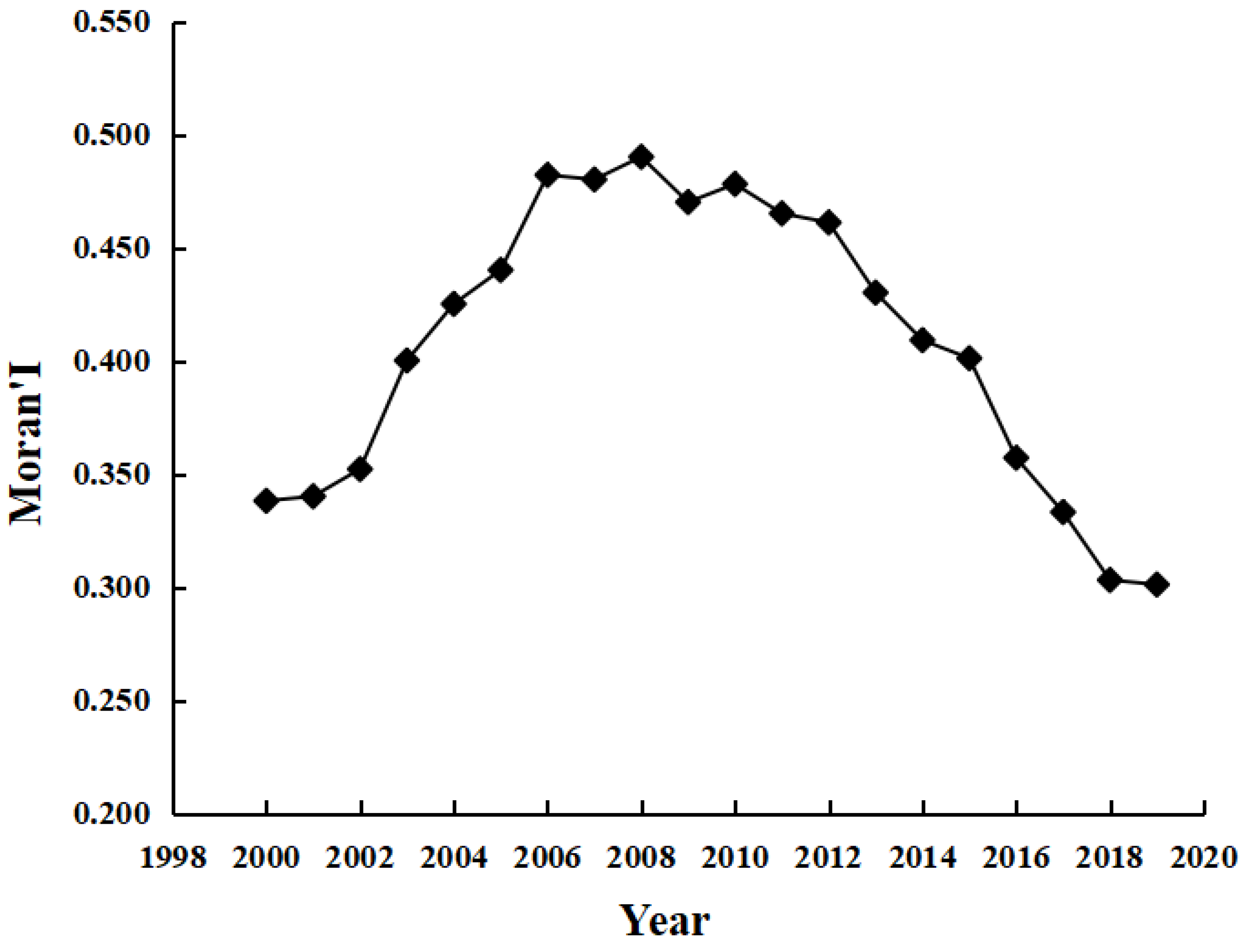

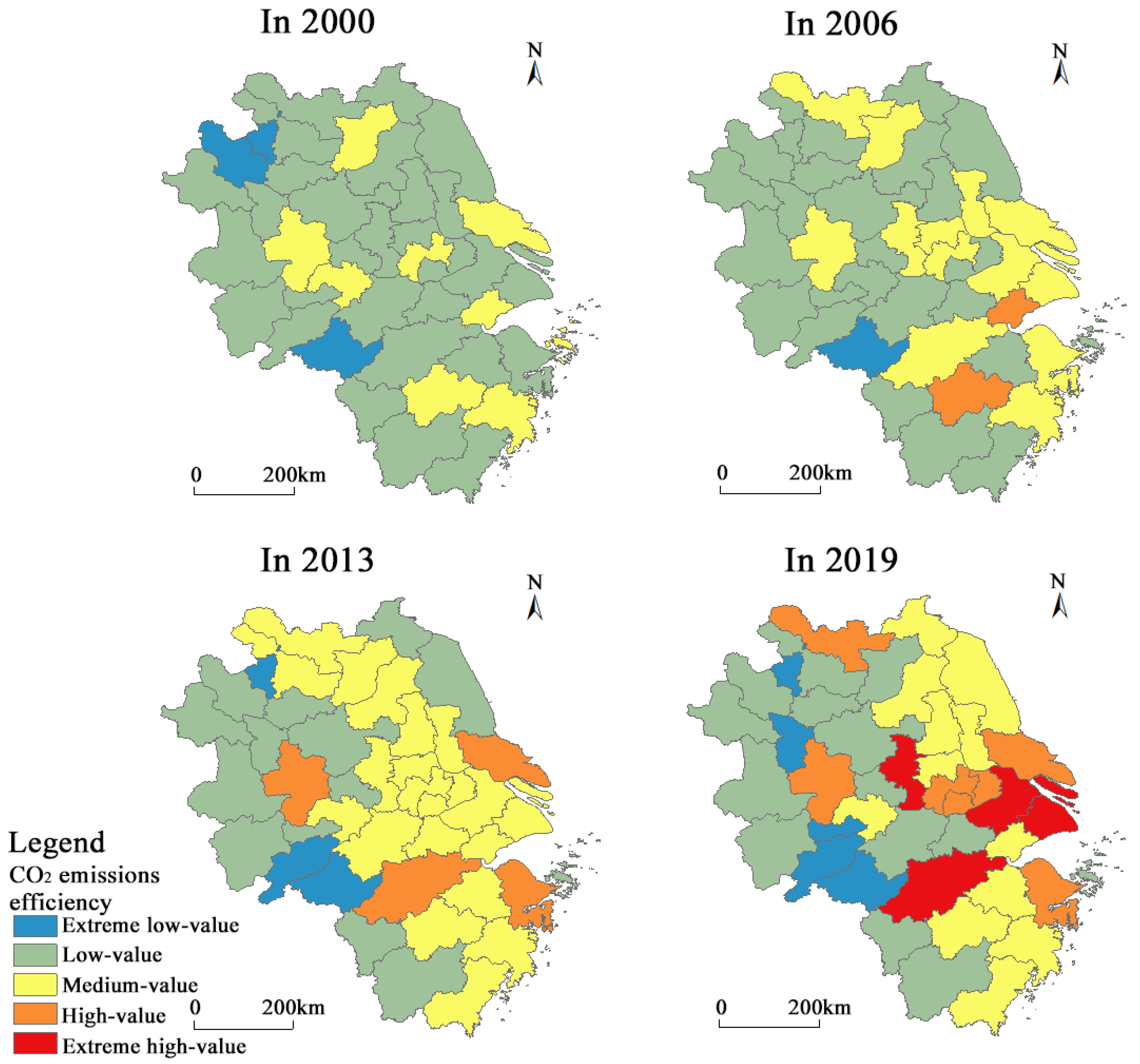
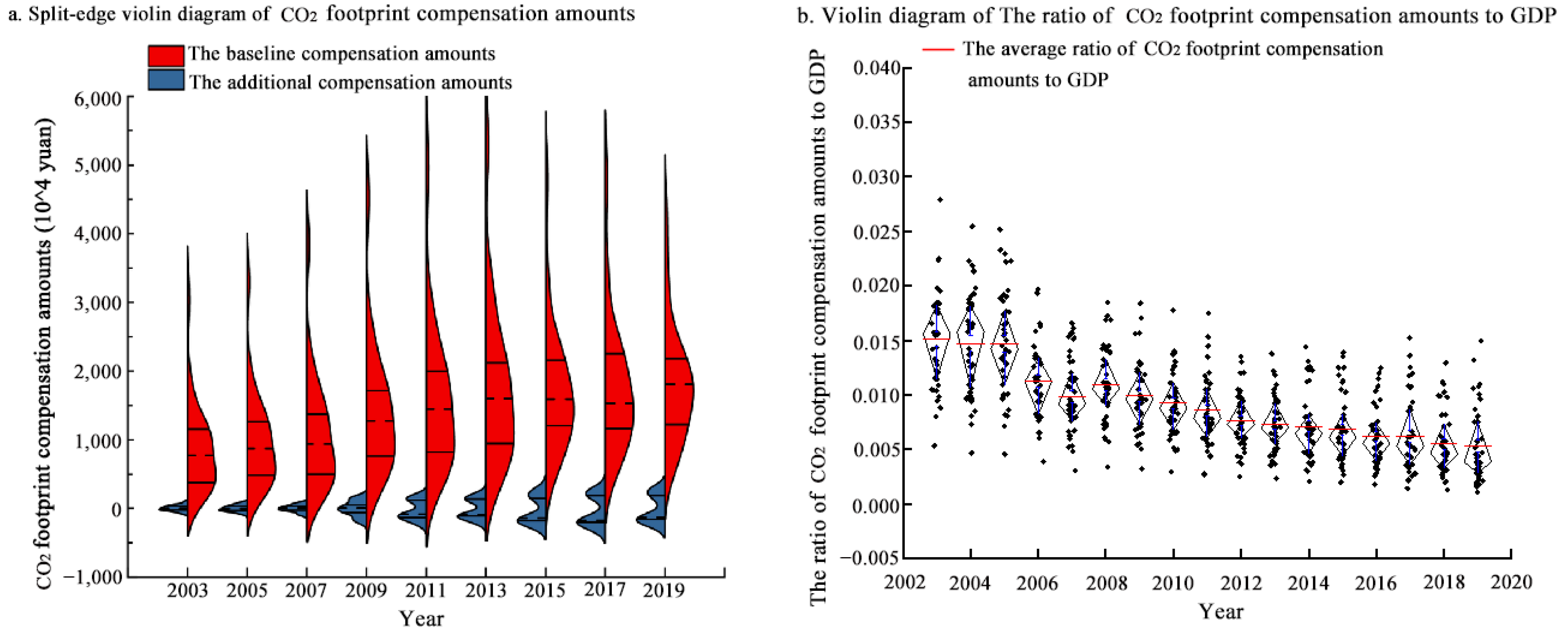


| Periods | ω | τ | R2 | Relative Error |
|---|---|---|---|---|
| 2000~2006 | 0.035 | 1 | 0.801 | 5.041% |
| 2007~2013 | 0.036 | 1 | 0.799 | 5.209% |
| 2014~2019 | 0.032 | 1 | 0.807 | 5.014% |
Disclaimer/Publisher’s Note: The statements, opinions and data contained in all publications are solely those of the individual author(s) and contributor(s) and not of MDPI and/or the editor(s). MDPI and/or the editor(s) disclaim responsibility for any injury to people or property resulting from any ideas, methods, instructions or products referred to in the content. |
© 2023 by the authors. Licensee MDPI, Basel, Switzerland. This article is an open access article distributed under the terms and conditions of the Creative Commons Attribution (CC BY) license (https://creativecommons.org/licenses/by/4.0/).
Share and Cite
Wang, L.; Zhang, Y.; Zhao, Q.; Ren, C.; Fu, Y.; Wang, T. Horizontal CO2 Compensation in the Yangtze River Delta Based on CO2 Footprints and CO2 Emissions Efficiency. Int. J. Environ. Res. Public Health 2023, 20, 1369. https://doi.org/10.3390/ijerph20021369
Wang L, Zhang Y, Zhao Q, Ren C, Fu Y, Wang T. Horizontal CO2 Compensation in the Yangtze River Delta Based on CO2 Footprints and CO2 Emissions Efficiency. International Journal of Environmental Research and Public Health. 2023; 20(2):1369. https://doi.org/10.3390/ijerph20021369
Chicago/Turabian StyleWang, Luwei, Yizhen Zhang, Qing Zhao, Chuantang Ren, Yu Fu, and Tao Wang. 2023. "Horizontal CO2 Compensation in the Yangtze River Delta Based on CO2 Footprints and CO2 Emissions Efficiency" International Journal of Environmental Research and Public Health 20, no. 2: 1369. https://doi.org/10.3390/ijerph20021369
APA StyleWang, L., Zhang, Y., Zhao, Q., Ren, C., Fu, Y., & Wang, T. (2023). Horizontal CO2 Compensation in the Yangtze River Delta Based on CO2 Footprints and CO2 Emissions Efficiency. International Journal of Environmental Research and Public Health, 20(2), 1369. https://doi.org/10.3390/ijerph20021369









